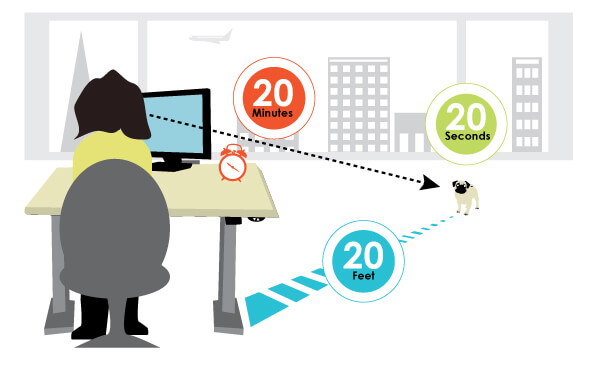In today’s digital world, it’s nearly impossible to avoid screens. Whether you’re working from home, scrolling through your phone, or binge-watching your favorite series, your eyes are constantly focused on digital devices. The result? Digital eye strain or computer vision syndrome can cause symptoms such as eye strain, dry eyes, blurred vision, and even headaches.
Fortunately, there’s a simple, free, and science-backed method that can protect your vision: the 20-20-20 rule.
In this article, we’ll break down what the 20-20-20 rule is, why it works, how to implement it, and what the science says. Plus, we’ll include helpful charts, FAQs, and practical tips for long-term eye health.
What Is the 20-20-20 Rule?
The 20-20-20 rule is a simple eye exercise designed to reduce digital eye strain. Here’s how it works:
Every 20 minutes, look at something 20 feet away for at least 20 seconds.
That’s it. It requires no apps, payments, or equipment—just a little time and awareness. This technique helps your eyes take a break from focusing on near screens, reducing fatigue and allowing them to relax.
Why the 20-20-20 Rule Works
When you stare at a screen for a long period, your eye muscles are in a constant state of contraction as they focus on close objects. Over time, this can lead to:
- Eye fatigue
- Blurred vision
- Dry eyes (due to less blinking)
- Headaches
- Neck and shoulder tension
Looking at something 20 feet away relaxes those muscles. It mimics natural eye movement and reduces stress on the focusing system of the eyes.
Digital Eye Strain: The Growing Problem
Digital eye strain affects a growing number of people worldwide. According to the American Optometric Association, over 58% of adults experience digital eye strain symptoms daily due to extended screen use.
Common Symptoms of Digital Eye Strain
| Symptom | Description |
|---|---|
| Eye fatigue | Tiredness or heaviness in the eyes |
| Blurred vision | Difficulty seeing clearly |
| Dry eyes | Reduced blinking, leading to irritation |
| Headaches | Often behind the eyes or temples |
| Neck/shoulder pain | Poor posture while viewing screens |
How to Implement the 20-20-20 Rule
Making the 20-20-20 rule part of your daily routine is easier than you think. Here’s how:
1. Set a Timer
Use your phone or computer to set a reminder every 20 minutes. Apps like EyeCare or Pomodoro timers can help automate this process.
2. Pick a Distant Object
Choose a landmark, picture, or even a window view that’s at least 20 feet away. Looking outside works great.
3. Blink Often
Make a conscious effort to blink. When you stare at a screen, your blink rate drops by almost 50%, causing dry eyes.
4. Combine With Stretching
While you’re giving your eyes a break, stand up and stretch. This helps relieve neck and shoulder tension as well.
Chart: 20-20-20 Rule vs. No Breaks – Benefits Comparison
| Feature | 20-20-20 Rule Followed | No Breaks Taken |
|---|---|---|
| Eye fatigue | Significantly reduced | Increased over time |
| Dryness/irritation | Less frequent | Common |
| Productivity | Maintained or improved | Often declines |
| Headaches | Less likely | More likely |
| Eye health (long-term) | Protected | At risk |
Benefits Beyond Eye Comfort
The 20-20-20 rule doesn’t just benefit your vision. It also supports:
- Mental clarity: Small breaks reset focus and improve concentration.
- Posture awareness: Encourages proper sitting and screen placement.
- Productivity: Reducing fatigue leads to more sustained, focused work.
FAQs: 20-20-20 Rule and Eye Health
Q1: Can the 20-20-20 rule prevent long-term vision problems?
While it won’t cure or prevent serious eye diseases, it helps reduce strain and protect eye function, especially for people who work on screens daily.
Q2: Is the 20-20-20 rule suitable for children?
Yes! In fact, it’s especially important for kids who spend hours on tablets or computers for school or gaming.
Q3: What if I can’t find something 20 feet away?
If you’re in a small room, just look as far away as possible. The goal is to shift your focus away from close-up work.
Q4: Can I combine this rule with other eye exercises?
Absolutely. Consider combining it with palming, blinking exercises, or adjusting your screen brightness and contrast.
Q5: How long does it take to see benefits?
Most people notice reduced eye strain within a few days of regular use. For long-term benefits, consistency is key.
Additional Tips for Screen Users
- Adjust screen brightness to match your environment.
- Use the 20-20-20 rule along with blue light filters or screen protectors.
- Maintain proper screen distance: about 25 inches from your eyes.
- Keep your screen at eye level to reduce neck strain.
- Get regular eye exams to detect any underlying issues early.
Conclusion
The 20-20-20 rule is a simple, free, and highly effective way to protect your eyes in a digital age. With screens playing such a central role in our lives, taking small, mindful steps can make a big difference in how your eyes feel—both today and years from now.
By building this easy habit into your day, you’re not just preventing discomfort—you’re investing in your long-term eye health.




